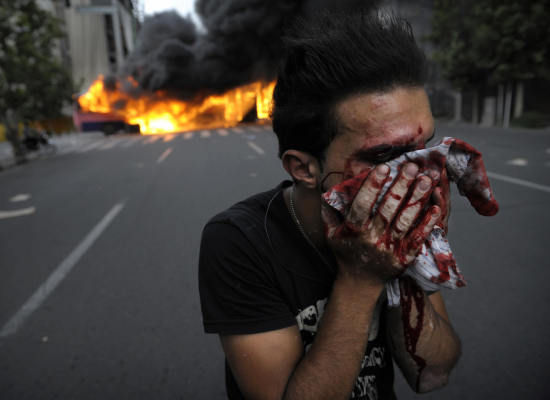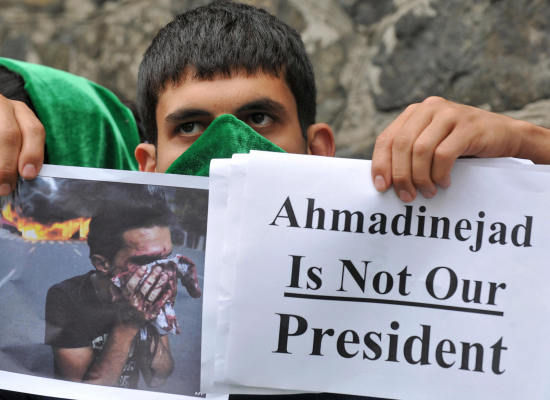The new media have been giddy with their up-to-the-minute coverage of the events in Iran this weekend. Direct comparison, compliments of Twitter, with CNN’s poor showing made the contrast all too obvious: The new media reports coming out of Tehran were equivalent to CNN coverage of the 1991 bombing of Baghdad. Better yet, the “revolution” unfolding today had erupted because Mousavi supporters had been able to text around state censorship of major media networks. Add to this the early photographs of hip, attractive students showing V signs and you might think that the whole thing was one big Obama rally. Except for this:

This guy got nailed. Broken nose, for sure, and maybe some teeth. His protest is over for the day. You can see how the injury has refocused his attention down to a single zone of pain and perception, the single preoccupation of holding his body together, the single act of getting himself to a safe place. The cloth that he is using to staunch the blood does additional work for us, as it can imply that he might want to weep, not for himself but for his cause, or that he might want to hide his face in shame, not from the blood but from the larger stain created by his government as it makes a sham of a democratic election.
But this is not the time for symbolism. As the government and its vigilantes are becoming increasingly violent, images (and videos) like this probably will become more prominent in the next day or two. With that, viewers are going to have to adjust the frame that was created by the initial news coverage online. Don’t get me wrong: I’ve been devouring reports by bloggers, Twitter feeds, and Facebook pages, all via various online aggregators. Even if some may be caught up a bit too much in promoting their own role in making history, the new media definitely are a part of the story. But the heart of the matter is that people have been putting their bodies on the line.
And let’s not forget that history still is being made the old fashioned way–by brutally beating people. Note this report on anti-Mousavi thugs from Samson Desta, a reporter for CNN (!), as printed at the Huffington Post: “They were plain clothes, carrying baseball bats. They were carrying metal pipes, and they were just beating up anyone that was that was in that area. Today, I went to a second protest…probably the most violent that I’ve seen, that we have seen. . . . No uniforms but they had weapons such as metal pipes, and they were actually just driving around, intimidating people, beating up people, anyone that was in the street, anyone that was in the road, anyone that dared to chant “Mousavi, Mousavi,” they were beating them senseless.”
Baseball bats, metal pipes, and blood. All we see here is the blood, which is but a trace of the violence. But it is a vital sign. Let’s not support the protesters because they are young and beautiful and connected; they should be supported because they are willing to risk all that for democracy.
Photograph from Getty Images/Huffington Post. Currently 41 photos of the demonstrations and reprisals are available at The Big Picture. Unfortunately, the point I’m trying to make here is vividly evident in the arc from the first image to #41. The list also includes another photograph (#16) of the man shown above. NCN readers may remember other posts on showing blood, including this one.
UPDATE:

I immediately recognized this photo as the one used by the UK’s Independent to accompany Robert Fisk’s article. In all the talk of “new media’s” instantaneous access, I think Fisk’s article is an example of how important an intelligent and articulate eye-witness still is. When good journalists can get out there to “the bodies on the line” instead of rewriting press releases, “old media” still trumps the “new” as far as I’m concerned.
Fisk’s article:
http://www.independent.co.uk/opinion/commentators/fisk/robert-fisk-iran-erupts-as-voters-back-the-democrator-1704810.html
So what about the picture? I have been reading about the troubles in Iran, and I knew that many of the protesters were “young and beautiful and connected,” as the blog states. Consequently, I “read” the photo as I (believe that I) am meant to: the kid is the victim of the explosion or the victim of state violence that resulted from the explosion. Either way, he’s the victim. But without any previous, extrinsic knowledge of the event to anchor this reading, one could conclude that bleeding man (boy, really) in the foreground suffered his injury in the act of creating the explosion we see in the background. I can see how this photo could become important in a series of images in which the context and the actors were put into stable roles, but on its own I think it needs a caption. Or at least it necessitates that its readers come to it with certain knowledge surrounding the events.
[…] demonstration. For an example using an earlier photo of state violence, look at the bottom of this post, and see others in photograph 9 at The Big Picture. That’s only part of the repertoire, […]
[…] of interest is an article posted today on No Caption Needed – ‘Showing Political Action: Images in the Iranian Protests’ – that shows how images of the protests are being used at subsequent protests. Refreshingly, […]
Interesting how this is still framed as ‘old’ versus ‘new’ media. It’s such a boring, negative, misguided way of understanding what is happening. It’s not a choice. It’s both. Iran was a fantastic example of how both work, often together.
http://www.charliebeckett.org/?p=1526
cheers
Charlie